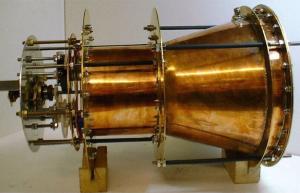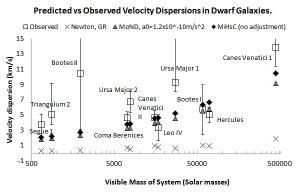Blog
Doing It Wrong
21 February 2017
Science isn’t easy. It isn’t supposed to be. The process of open publication, peer review and clear data are a part of science because they help us understand how the Universe works. It can be inconvenient and contentious, but it works. Through this process, new ideas are faced with an uphill battle. This is particularly true of ideas that would contradict the foundational theories of physics. So it’s tempting to react to such opposition by playing a different game. Rather than addressing criticism, you start building a story where your idea is obviously right, and others are simply too closed-minded to see it. Down that path lies pseudoscience, and sometimes you can watch it happening. Take for example, Mike McCulloch‘s theory of Modified inertia by a Hubble-scale Casimir effect (MiHsC), also known as quantized inertia.
McCulloch’s model has been in the works since 2008, but it has become popular in recent years due to its connection to the EMDrive. You might recall this as the device that (according to its proponents) can create a thrust without any traditional propellant which could revolutionize space travel and take us to the stars. The EMDrive has created quite a stir among the general public because of the tremendous possibilities if it succeeds. Meanwhile, scientists have noted that even the best experimental results can’t be distinguished from background noise, and that such a device would violate basic physics. McCulloch argued that the effect was not only real, but that it could be explained in the context of his model.
The basic idea of MiHsC is that inertia is caused by Unruh radiation. Inertia is a basic property of matter, and means that the velocity of an object will remain constant unless a force acts on it. It is the basis of Newton’s first law of motion. Unruh radiation has never been observed, but it appears in quantum physics. In quantum theory, empty space can be described as being filled with a quantum field. A vacuum, in this view, is simply the lowest possible energy state for these fields. In most cases empty space looks like a vacuum as we’d expect, but for an accelerating observer the field has an observed energy. As a result, an accelerating observer would be heated by quantum particles known as Unruh radiation. McCulloch argues that when an object accelerates it interacts with Unruh radiation, which causes the object to resist a change of motion. Thus inertia is an effect of acceleration rather than an inherent property of matter.
There are problems with this idea from the get-go. For one thing, the Unruh effect in standard quantum theory is extraordinarily small. If you accelerated a trillion times greater than Earth gravity, you’d only see a thermal temperature of 40 billionths of a degree above absolute zero. Furthermore, since Unruh radiation comes from all directions, it couldn’t create the effects of inertia on its own. But rather than be deterred by this, McCulloch adds other effects into the mix. Since the observable universe is finite, the wavelengths of Unruh radiation is limited, and combined with a cosmic Casimir effect and a bit of information theory, can somehow produce the effect of inertia. The Unruh effect, Casimir effect and information theory are all well established in modern physics, but their hodge-podge combination in MiHsC is misapplied.
 NASA Spaceflight Forum
NASA Spaceflight ForumHowever even this isn’t enough to explain the EMDrive. In his paper on the EMDrive, McCulloch argued that photons have mass, and that photon mass varies with time.1 The time-varying inertia allows the EMDrive accelerate. The idea not only violates Newton’s third law of motion, it violates special relativity, general relativity, and Noether’s theorem. Since these are each well tested theories that form the basis of countless other theories, their violation would completely overturn all of modern physics. It’s no wonder most scientists have been aggressively skeptical of the idea. This criticism could be overcome by working out the specific details of MiHsC, clearly addressing these kinds of problems. But that would be extremely difficult given just how strongly verified these theories are. The alternative is to double down, count the EMDrive as a win, and start looking at other strange effects to explain. Because once you allow yourself to ignore basic physics in your theory, all sorts of phenomena can be explained.
 M.E. McCulloch
M.E. McCullochfor some dwarf galaxies.
In his most recent work, McCullogh claims MiHsC can explain the odd behavior of rotating galaxies. It’s long been known that galaxies rotate faster than expected. Given the amount of mass we can directly see in a galaxy, most of them should simply fly apart.2 The most popular solution to this conundrum is that galaxies contain dark matter, but other ideas such as Modified Newtonian Dynamics (MoND) have been proposed. Like MoND, MiHsC proposes that the inertia of an object is less at small accelerations, so the weak gravity of a galaxy can keep stars from flying away. Starting with an equation for modified inertial mass, the paper derives the predicted rotation speeds for several dwarf galaxies.3 It then compares observed rotation speeds with the predictions of Newtonian gravity (without dark matter), MoND, and MiHsC. Newtonian gravity fails (as has long been known), and the other two models agree with the data equally well, though with uncertainties on the order of 30% calling the data a good fit is a bit generous. McCullogh then argues that MiHsC is inherently better than MoND, since MoND relies upon an adjustable parameter. Nevermind the fact that MiHsC violates established physics, while MoND is simply descriptive.
By itself this is pretty standard for a speculative paper: here’s a wild idea, it can kinda explain a strange physical effect, maybe it’s worth exploring further. It’s a kind of “what if” paper that could lead to interesting models, but doesn’t really prove anything. Sure, MiHsC roughly agrees with the galaxy rotation curves, but so do a dozen other speculative models. But McCullogh claims on his blog that the model not only predicts galactic rotation curves without dark matter, it predicts cosmic expansion without dark energy, solves the Pioneer anomaly, and the flyby anomaly, could be used to create free energy through sonoluminescence, etc. It’s everything we could ever wish for. These claims reiterated in the popular press without any critical analysis. As a result, the model has built up a fan following who think that skeptical scientists are just haters trying to bury the next Einstein.
But that’s not how science is done. To be a viable model MiHsC will have to address its contradictions with established theories, and that will prove extremely difficult. Claiming victory is easier, but it’s an approach that will only get you lost in the woods.
McCulloch, M. E. “Testing quantised inertia on the emdrive.” Europhysics Letters 111.6 (2015): 60005. ↩︎
McCulloch, M. E. “Low-acceleration dwarf galaxies as tests of quantised inertia.” Astrophysics and Space Science 362.3 (2017): 57. ↩︎
McCulloch, M. E. “Modelling the Pioneer anomaly as modified inertia.” Monthly Notices of the Royal Astronomical Society 376.1 (2007): 338-342. ↩︎